

The Endocrine System. 2-Minute Neuroscience: Pineal Gland. 8.1.2 Local and Circulating hormones. Endocrine System, part 1 - Glands & Hormones: Crash Course A&P #23. Endocrine System, part 2 - Hormone Cascades: Crash Course A&P #24. Endocrine glands and hormones. Negative feedback loops. Hypothalamus and pituitary gland. Homeostasis and Negative/Positive Feedback.
Insulin and Glucagon: How Do They Work? Introduction Insulin and glucagon are hormones that help regulate the levels of blood glucose, or sugar, in your body.
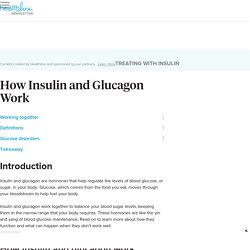
Glucose, which comes from the food you eat, moves through your bloodstream to help fuel your body. Insulin and glucagon work together to balance your blood sugar levels, keeping them in the narrow range that your body requires. These hormones are like the yin and yang of blood glucose maintenance. Read on to learn more about how they function and what can happen when they don’t work well. How insulin and glucagon work together Insulin and glucagon work in what’s called a negative feedback loop. How insulin works During digestion, foods that contain carbohydrates are converted into glucose. The insulin tells cells throughout your body to take in glucose from your bloodstream. Read more: Simple vs. complex carbs » How glucagon works Glucagon works to counterbalance the actions of insulin. This whole feedback loop with insulin and glucagon is constantly in motion. Type 1 diabetes. Endocrine System: Discover the Anatomy and Function of Glands.
The endocrine system includes all of the glands of the body and the hormones produced by those glands.
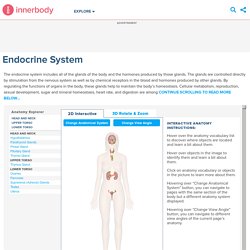
The glands are controlled directly by stimulation from the nervous system as well as by chemical receptors in the blood and hormones produced by other glands. By regulating the functions of organs in the body, these glands help to maintain the body’s homeostasis. Cellular metabolism, reproduction, sexual development, sugar and mineral homeostasis, heart rate, and digestion are among Continue Scrolling To Read More Below... Continued From Above...
The many processes regulated by the actions of hormones. Description, Function, Glands, & Hormones. Feedback regulation mechanisms of endocrine signaling A constant supply of most hormones is essential for health, and sustained increases or decreases in hormone production often lead to disease.
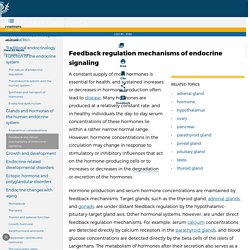
Many hormones are produced at a relatively constant rate, and in healthy individuals the day-to-day serum concentrations of these hormones lie within a rather narrow normal range. However, hormone concentrations in the circulation may change in response to stimulatory or inhibitory influences that act on the hormone-producing cells or to increases or decreases in the degradation or excretion of the hormones. Description, Function, Glands, & Hormones. Endocrine gland secretion is not a haphazard process; it is subject to precise, intricate control so that its effects may be integrated with those of the nervous system and the immune system.

The simplest level of control over endocrine gland secretion resides at the endocrine gland itself. The signal for an endocrine gland to secrete more or less of its hormone is related to the concentration of some substance, either a hormone that influences the function of the gland (a tropic hormone), a biochemical product (e.g., glucose), or a biologically important element (e.g., calcium or potassium). Because each endocrine gland has a rich supply of blood, each gland is able to detect small changes in the concentrations of its regulating substances.
Some endocrine glands are controlled by a simple negative feedback mechanism. Paper 12 19247 806. Hormone Regulation ( Read ) On or off?
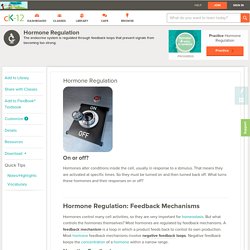
Hormones alter conditions inside the cell, usually in response to a stimulus. That means they are activated at specific times. So they must be turned on and then turned back off. Hacking Into Your Happy Chemicals: Dopamine, Serotonin, Endorphins, & Oxytocin. Loading...
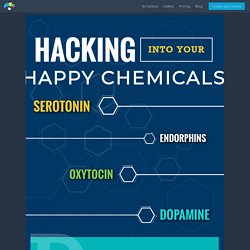
Dopamine motivates you to take action toward your goals, desires, and needs, and gives you a surge of reinforcing pleasure when achieving them. Procrastination, self-doubt, and lack of enthusiasm are linked with low levels of dopamine. Break big goals down into little pieces so you can create a series of little finish-lines which releases dopamine. Create new goals before achieving your current one. That ensures a consistent pattern for experiencing dopamine.
Hacking Into Your Happy Chemicals: Dopamine, Serotonin, Endorphins, & Oxytocin. You might not have a money tree, but you can have a happiness tree.

Dopamine, Serotonin, Oxytocin, and Endorphins are the quartet responsible for your happiness. Many situations can trigger these neurotransmitters, but instead of being in the passenger seat, there are ways you can intentionally cause them to flow. Being in a positive state has significant impact on your motivation, productivity, and wellbeing. Here are some simple ways to hack into your positive neurochemicals: [Download the free infographic below!] Dopamine Dopamine motivates you to take action toward your goals and gives you a surge of reinforcing pleasure when achieving them. Break big goals down into little pieces. You and Your Hormones from the Society for Endocrinology. Alternative names for oxytocin Alpha-hypophamine; manufactured versions – carbetocin, syntocinon and pitocin What is oxytocin?

Oxytocin is produced in the hypothalamus and is secreted into the bloodstream by the posterior pituitary gland. Secretion depends on electrical activity of neurons in the hypothalamus – it is released into the blood when these cells are excited. The two main actions of oxytocin in the body are contraction of the womb (uterus) during childbirth and lactation. More recently, oxytocin has been suggested to be an important player in social behaviour. Somatostatin. Advanced endocrine system physiology. Thyroid, Parathyroid, Adrenal, Endocrine Surgery, The Connection between the Pituitary and Hypothalamus?
Performance-enhancing drugs: Know the risks. Performance-enhancing drugs: Know the risks Hoping to gain a competitive edge by taking performance-enhancing drugs?
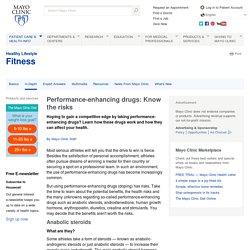
Learn how these drugs work and how they can affect your health. By Mayo Clinic Staff Most serious athletes will tell you that the drive to win is fierce. Besides the satisfaction of personal accomplishment, athletes often pursue dreams of winning a medal for their country or securing a spot on a professional team. But using performance-enhancing drugs (doping) has risks. Anabolic steroids What are they? Some athletes take a form of steroids — known as anabolic-androgenic steroids or just anabolic steroids — to increase their muscle mass and strength. Testosterone has two main effects on your body: Anabolic effects promote muscle building.